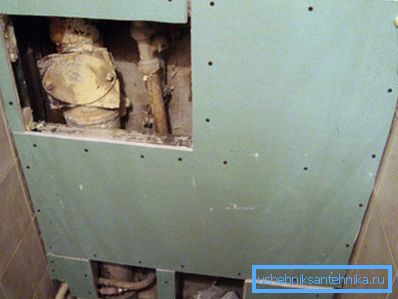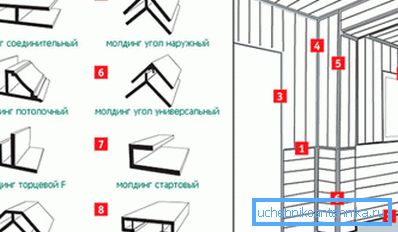How to close the pipes in the toilet: how to transform the
With all the desire sewage and water pipes can not be called decoration bathroom. They look like a foreign body on the background of beautifully tiled walls and spoil the whole impression of the room. For this reason, many are thinking about how to close the pipes in the toilet with plastic panels.

How can I hide the pipes in the bathroom?
You can make sewers and plumbing invisible in several ways, most often a false wall is built for this, which is then sheathed with any suitable material.
But there are other, more labor-intensive ways, so when asked how beautifully to close the pipes in the toilet there are several answer options:
- In the past, in the walls of the gateway dredging for the pipeline. This is a very laborious occupation, and in the case of a leak, all repairs went down the drain, because in that case you had to knock some of the plaster off the walls. In addition, when gouging, pipes with a diameter of only up to 50 mm can be hidden, and strobing can be done to a depth not exceeding 15% of the wall thickness;

- Nowadays false walls are often used for this, their construction is simple and all the work can be done by hand.. It creates a frame of steel profiles, which is then sheathed with moisture-resistant hypocardone or plastic panels;

- If the width of the room is small, then the water supply and sewage can be hidden behind the roller shutters. The price of such a solution will be slightly higher than, for example, the use of a drywall box, but there will be no obstacles in repairing or cleaning the pipeline.

Most often, to solve this problem, plasterboard or plastic panels are used. Plastic is more practical, because the panels can be simply removed from the frame during repairs, and plastic is not afraid of moisture. On the other hand, drywall has no restrictions on the surface finish, it can be tiled, painted, etc.
Using plastic panels to close the pipeline
Regardless of what material is planned to be used for plating, in general, instructions for the construction of a false wall remains the same:
- markings on the floor and ceiling;
- guide profiles are attached to the floor and ceiling, and racks are attached to the walls;
- Rack profiles are installed in the corners of the contour of the future box;
- To give rigidity to the structure, transverse profiles are mounted with a pitch of about half a meter;
- sheathing is performed. In more detail the question of how to hide the pipes in the toilet with plastic panels is discussed below.
Markup
First, the contour is applied to the floor. Observance of right angles while you need to control the angle. After that you need to move the contour from the floor to the ceiling.
A rack profile is installed in the corners of the future box, with the help of the construction level it is brought into a strictly vertical position and a point is marked on the ceiling - a projection of the contour from the floor.

Note! In order to match the contour of the box on the floor and ceiling, it is imperative to check the horizontal position of the floor before marking.
Frame Mounting
Regarding how to close the sewer pipes in the toilet, there may be a lot of solutions, but the framework will be needed in most cases. The best option can be considered galvanized metal profiles (profiles for drywall). The metal guarantees the required rigidity, and the protective coating will protect the steel from corrosion.

It is better not to use wooden blocks for this, because the tree needs to be treated with antiseptic. Yes, and fire safety in this case decreases.
Note! For plastic panels, you can use a plastic crate. In this case, the installation can be performed using special clips. The main drawback of the plastic frame can be considered low rigidity.
Installation begins with the installation of profiles on the floor, then mounted vertical racks, and the transverse ribs are installed last. Between themselves, the profiles are connected with special screws.

If all the work is done by hand, then you need to pay attention to the step between the edges of the frame. If the plastic panels are oriented from the bottom up, then you can take the distance between the ribs of the order of 50 - 80 cm. If they are installed in the transverse direction, then you may need to install an additional rack.
Note! When installing, you need not to forget that in front of the revision, fittings will have to make a window for quick access. The contour of the window you need to create at the stage of mounting the frame.

Covering the frame with plastic panels
Now it remains only to fix the plastic panels on the profiles. In addition to the panels themselves, moldings will also be needed, in particular, the inner and outer corners, as well as the starting molding.

Before installation, you need to decide how to fasten the panels to the frame.
In general, there are such fastening methods:
- self-tapping screws;
- nails (in the case of wooden frame);
- with glue. It should be understood that when the issue is solved how to close the pipes in the toilet, at any time it may be necessary to dismantle the false walls. Glue is not the best option in this case;
- steppler;
- Klyamer
- clips, only in case of use of a plastic framework.
Acceptable speed of work and the ability to quickly disassemble the structure if necessary, gives the mounting screws.
Sheathing is performed in the following sequence:
- the trim starts with the installation of the starting molding against the wall. By self-tapping screws it fastens to a profile, and fastening happens through a shelf which is blocked by the following panel. Thanks to this, the screw head is not visible;

- then the protrusion of the next panel is inserted into the groove and slides in to the end. On the free side of the panel is fixed screws. According to this scheme, the walls of the box are sheathed;

- door mounted in the wall;
- the corresponding molding is installed on the outer corner; the junction between the box and the ceiling and the floor is also finished.
At this point, the question of how to close the pipes in the toilet can be considered resolved. It remains perhaps to wipe the plastic from dust.
Note! It is forbidden to make the box deaf, in the upper part it is necessary to provide a vent hole with a diameter of at least 5 cm. If there is a heating system behind the wall, then a whole group of small holes can be drilled along them.

Summarizing
The article describes a specific example of how to close the pipes in the toilet. The proposed option can be considered optimal, because it provides an excellent appearance of the bathroom and allows, if necessary, to quickly repair the sewage system and plumbing.
The video in this article focuses on the proper installation of profiles under the false wall.